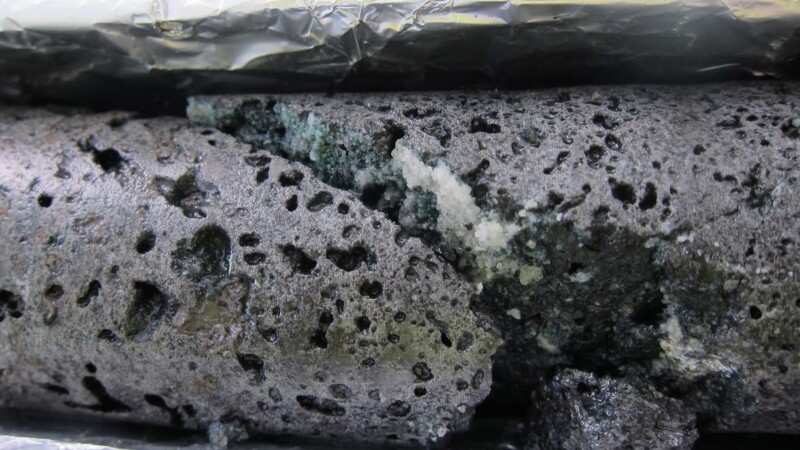In a world increasingly impacted by the effects of climate change, there is growing awareness for the need to curb greenhouse gas emissions. However, realistic scenarios of future CO2 emissions, such as those presented by the IPCC Special report on global warming of 1.5 °C, recognize that we will have to go even further. Beyond achieving carbon neutrality, substantial negative emissions will be required by the mid-21st century to achieve such goals. Furthermore, CO2 emissions are hard to avoid in industries where they are generated through process emissions.
Carbon capture and storage (CCS) is a solution to such problems, where CO2 is removed from emission streams or captured directly from the air (called Direct Air Capture [DAC]) followed by long-term subsurface storage. Conventionally, CCS projects have been focused on using sedimentary formations such as depleted oil reservoirs, deep saline aquifers, or coal seams to store CO2. In these cases, supercritical CO2 is injected into rock formations overlain by an impermeable cap rock preventing the buoyant CO2 from rising back to the Earth’s surface. There are four mechanisms by which CO2 is trapped in these formations: 1) structural trapping, 2) residual (capillary) trapping, 3) dissolution trapping, and 4) mineral trapping. The storage security increases as each trapping mechanism is activated going from mechanism 1 to mechanism 4, respectively. The timescale of the occurrence of these mechanisms in typical sedimentary formations, however, also increases, and significant mineral trapping only occurs on geological timescales.
A safer alternative is to find a method that accelerates the dissolution and/or the mineral trapping mechanisms and, hence, increases the security of CO2 storage underground. Researchers in Iceland, Europe, and the US were able to identify such a method in what is termed the “Carbfix” process. In the Carbfix process, the CO2 is dissolved into water, either before or during its injection into the subsurface, where the CO2-charged water is denser than other reservoir fluids, and thus naturally sinks to deeper levels. Furthermore, the slightly acidic water readily reacts with reservoir rocks, and solid carbonate minerals such as calcite are formed within weeks to months, mineralizing the CO2 and storing it for geological timescales. The Carbfix process does not require a cap rock above the storage formations and can thus be applied in a variety of locations around the world where suitable rock types such as basalts are available. The method depends on the availability of water in which the CO2 can be dissolved and the reactivity of the reservoir rocks. Experimental results demonstrated that seawater is suitable for this purpose, reducing costs and avoiding potential usage conflicts in regions of water shortage.
The Carbfix method was developed through collaboration of academia and industry with major financial support by research grants from the European Union as well as other agencies in Iceland and the US. Following the project’s initiation in 2006 and preparatory research, test injections were conducted near a geothermal power plant in Iceland in 2011. The success from this test, showing that 95% of the CO2 was mineralized within 2 years, led to the industrial application of this method at the same power plant in 2014. This CO2 capture plant currently has capacity for around 12,000 tonnes of CO2 (tCO2) per year. This will soon be accompanied by a DAC plant capturing 4,000 tCO2 from the air each year, and further applications of the Carbfix CCS method are ready to be implemented in other places in Iceland and abroad. Apart from the increased safety compared to conventional CCS, the attractiveness of the method is also owed to its competitive cost of around $25/tCO2 compared to alternative CCS methods or the cost to offset carbon emissions under increasingly tight regulations.
The successful initiation and development of this method is the product of collaboration between scientists and experts with a variety of skill sets. On the storage side, geochemists, geologists, and reservoir engineers work together to study the feasibility of CO2 mineralization in different reservoirs and injection scenarios. Geochemists and geophysicists are also heavily involved when monitoring ongoing injections. Optimizing the CO2 capture process requires both chemical and process engineering to assess different gas and water streams from emission sources. Apart from these technical aspects, expert work is also required for the inclusion of such CCS methods into regulatory frameworks, and outreach activities are key for promotion and public acceptance. As greenhouse gas emissions are still on the rise today, it is likely that CCS activities will become even more crucial as time passes. Therefore, students and young professionals today will have to play a major role in upscaling CCS methods such as the Carbfix process. From the beginning, early career scientists were actively involved in various aspects of this project, and many of them are now in leading roles continuing to train young professionals for similar roles in both academia and industry.
[The article was sourced from the author by TWA editor Muhammad Almajid.]


